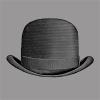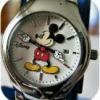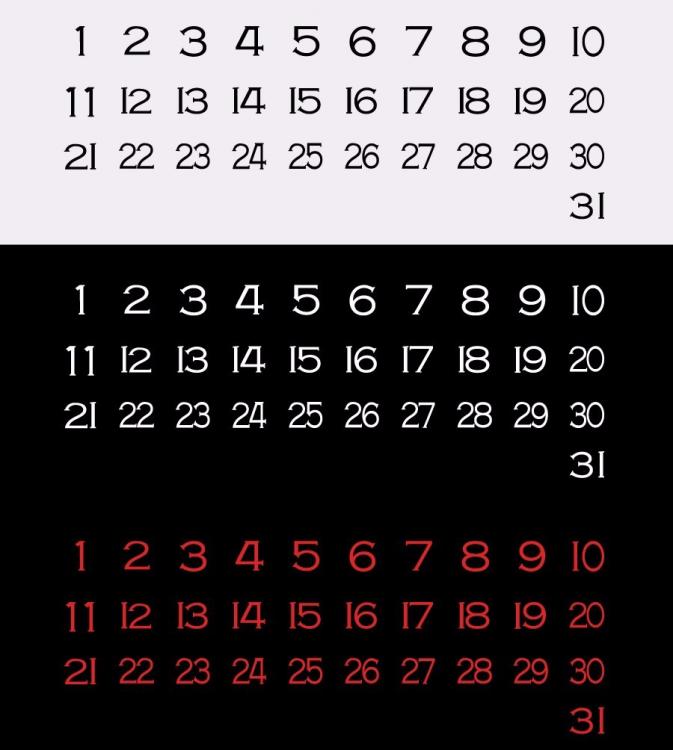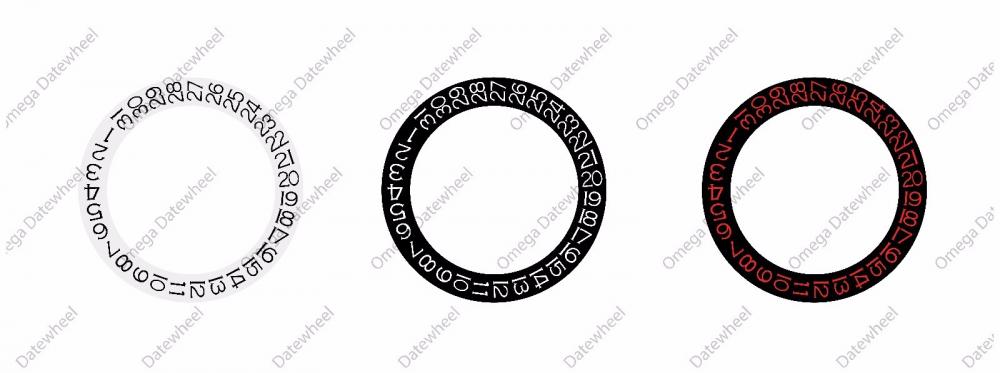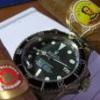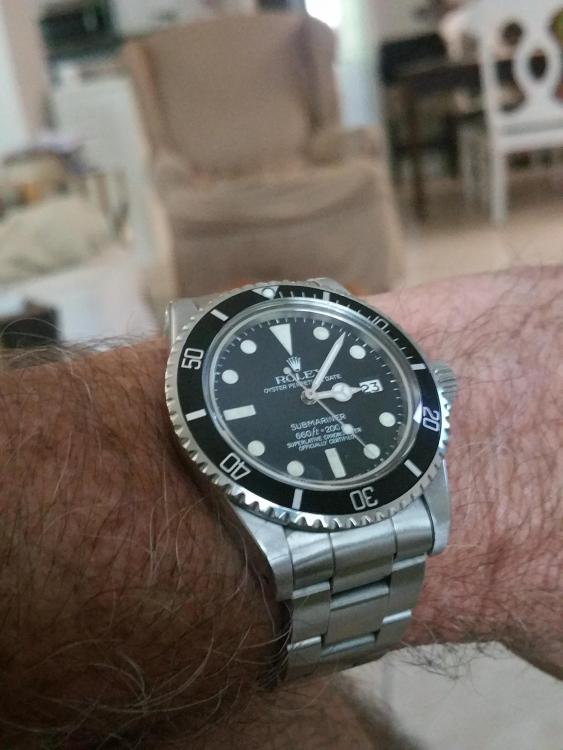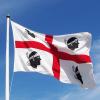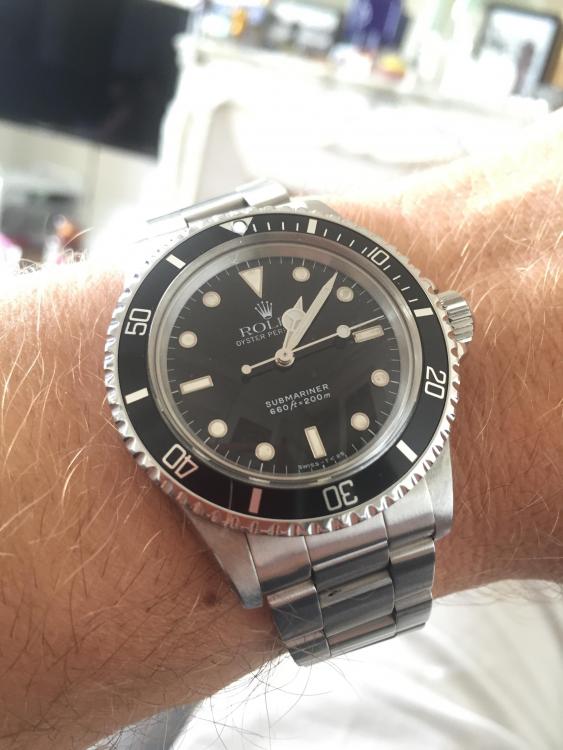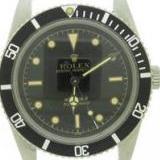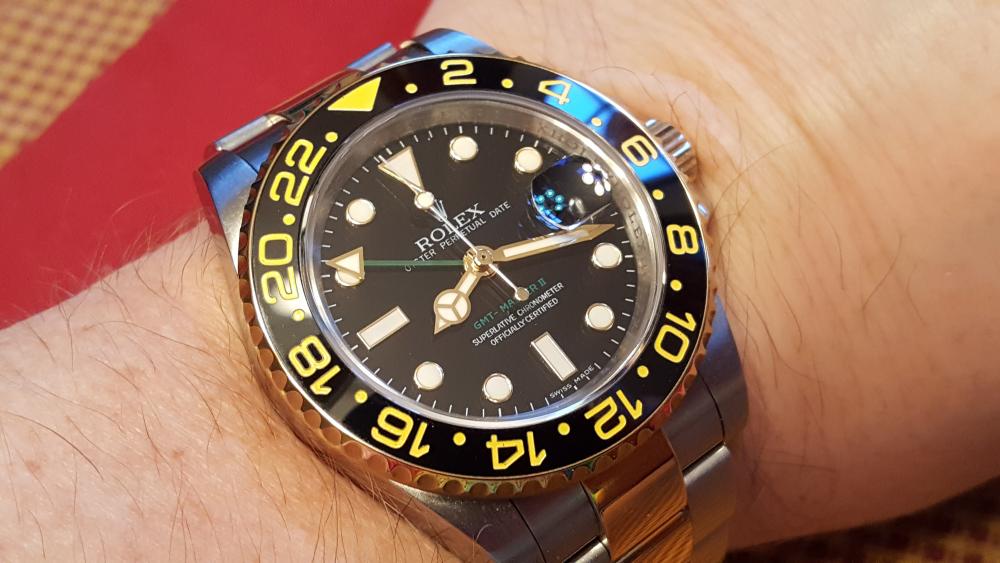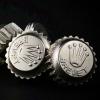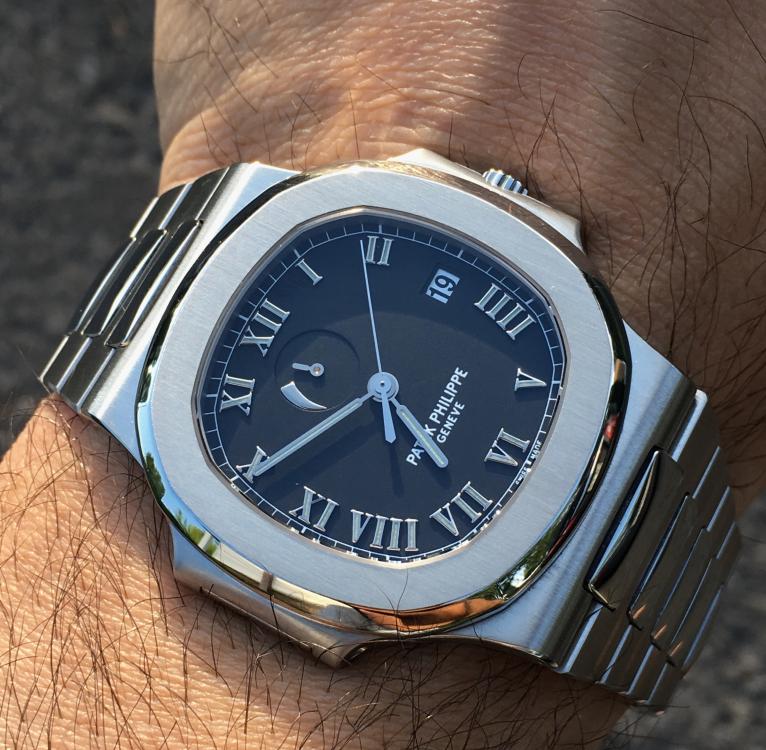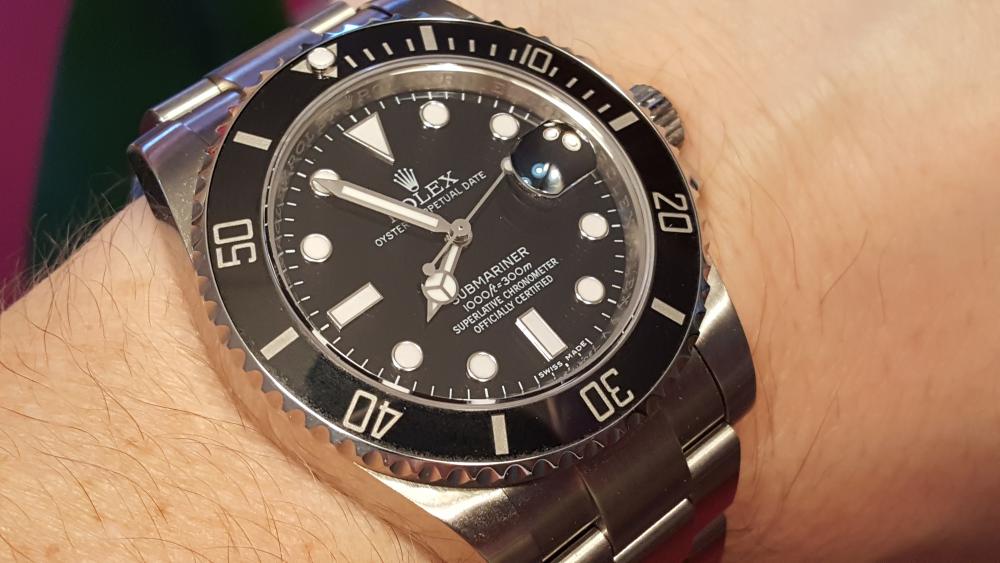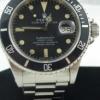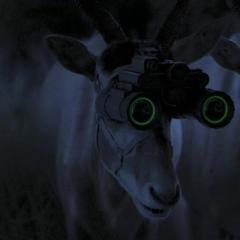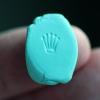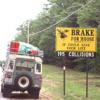When you buy through links on our site, we may earn an affiliate commission.
Leaderboard
Popular Content
Showing content with the highest reputation on 07/23/2016 in all areas
-
2 points
-
2 points
-
If You where sailing the seven Seas tomorrow - You´d wear a 1675 Pepsi GMT Master. The red and blue, vintage and gilt expedition watch at the dockyard the other day.2 points
-
2 points
-
Watchmaking Glossary AMPLITUDE The measure of the amount of rotation in the swing of the balance wheel, in either direction, usually expressed in degrees. In a running watch, the balance wheel swings or rotates clockwise and counterclockwise. Each swing in either direction is called a “beat”. Amplitude is the number of degrees of rotation of the beat. Amplitude is higher, typically in the range of about 270 to 315 degrees, when a watch is lying flat or in the “dial up” or “dial down” position. Amplitude usually falls when the watch is in a vertical position, primarily due to increased friction. Amplitude can also fall as the watch winds down and the mainspring delivers less power. Amplitude that is too high or too low, or that changes too much in different positions, can indicate a problem with the movement. ANA-DIGI A quartz watch with both analog and digital displays (see definitions below). ANALOG Displaying the time by means of hands rotating around a dial. (Compare with “digital” below). ANCHOR ESCAPEMENT See “lever escapement” below. ANGLAGE Beveling, or creating an angled edge, on a movement component such as a bridge. Anglage is performed either mechanically with a pantographic engraver or manually with a hand-held file. Ideally, the angle on the edges should measure precisely 45 degrees. Anglage is usually a feature of high-quality movements. ANNUAL CALENDAR A calendar mechanism that adjusts automatically for the different lengths of the months March through January. It need be reset just once a year, at the end of February, because it doesn’t “know” whether February has 28 or 29 days in a given year. (Compare with “perpetual calendar,” below.) ANTIMAGNETIC Protected against the effects of magnetic fields, which can affect a movement’s precision by influencing the balance’s rate of oscillation. One way to protect against magnetism is to make the balance and balance spring of metals that either cannot be magnetized or are resistant to becoming magnetized (e.g., Elinvar or Nivarox hairsprings used in conjunction with brass, nickel or beryllium bronze balances). Other delicate components, specifically the lever, escape wheel and impulse roller, can also be made of nonmagnetic metals. Another way to protect against magnetism is to enclose the entire movement in a case made from a highly conductive alloy, which prevents magnetic fields from building up inside it. A watch can be described as antimagnetic if, within a magnetic field of 4,800 A/m (amperes per meter), it continues to run with a deviation of no more than 30 seconds per day. One symptom that suggests that a watch has been magnetized is a tendency to run slow. A magnetized watch can be “cured” (i.e., demagnetized) by a watch repairer using a choking coil. APPLIED INDICES (APPLIQUÉ INDICES) Raised metal numbers or batons attached to the dial via adhesion or pegs. ART DECO Design style of the 1920s and ’30s. Most tonneau- (barrel-) shaped and rectangular watches were inspired by the art deco movement. AUTOMATIC MOVEMENT A mechanical movement whose mainspring is wound by means of a built-in rotor that swings around its axis when the wearer moves his arm. BALANCE The regulator, or oscillator, in a mechanical watch. The balance is a wheel that rotates back and forth on an axle, its motions governed by the coiling and uncoiling of the hairspring, or balance spring. The precision of the timepiece depends to a very large degree upon the construction of the balance. Most modern watches have balances that oscillate 21,600 or 28,800 times per hour (often abbreviated “vph,” for “vibrations per hour), but some have lower or higher frequencies, such as 18,000 or 36,000 vph. BEAT The vibration (half-oscillation, or “tick”) of a movement. BEZEL The ring around a watch dial that typically holds the glass or crystal covering the dial in place. Many watches have rotating bezels that can be turned to measure elapsed time or to indicate the time in a second time zone. BREGUET OVERCOIL HAIRSPRING A hairspring with a sharply curved outer end. This terminal curvature improves the spring’s concentric development compared to hairsprings with flat spirals. BRIDGE A flat, typically narrow metal piece secured to the plate (see below) at both ends and drilled with a hole or holes into which jewels (see below) may be fit that hold the rotating pivot(s) of a moving part or parts. CABOCHON A smooth, unfaceted gemstone cut in a convex shape. Cabochons are sometimes set on winding crowns for decoration. CALIBER A specific watch-movement model, usually denoted by a number or alphanumeric name, as in Caliber 7750 (ETA’s famous automatic chronograph caliber) or Caliber CH 29 535 (Patek Philippe’s new manual-wind chronograph caliber). CENTER, OR SWEEP SECONDS HAND A seconds hand mounted in the center of the dial rather than in a subdial. The arbor of the center wheel is hollowed out to make room for the shaft of the seconds hand. CHAPTER RING Circle on a watch dial, near the dial’s edge, bearing the hour, and sometimes minute, numerals or indices CHRONOGRAPH A device that measures elapsed time, i.e., a stopwatch. The word can be used to denote the device itself or a watch that incorporates the device. Most modern chronograph watches are equipped with a center-mounted seconds hand for showing the elapsed seconds and a subdial or subdials to show the elapsed minutes and, on some watches, the elapsed hours. A standard chronograph has two pushers on the side of the case. The top one is used to start and stop the chronograph function and the bottom one to return the elapsed seconds, minutes, and, when present, hours hand to zero. CHRONOMETER A watch that has passed a battery of timing tests administered by an official chronometer-certification agency such as COSC (see below). Decades ago the word was used differently, and meant a timepiece with a so-called “chronometer” or “detent” escapement, or any very accurate timepiece. COLUMN WHEEL The upright, notched, rotating wheel in a chronograph that acts as a sliding link to operate the various levers that turn a chronograph on and off and return the chronograph hands to the zero position. Not all chronographs have column wheels; many use an alternative on-off switching system called “cam switching.” COMPLICATION A device in a watch movement that performs a function other than straight timekeeping. Complications include, but are not limited to, calendars, chronographs, repeaters (see below) and alarms. COSC (OR C.O.S.C.) Abbreviation for “Contrôle officiel suisse des chronomètres,” French for “Swiss chronometer testing bureau.” COSC is a Swiss-government-sponsored agency that tests watches submitted to it and issues chronometer certificates to those that are precise enough to meet COSC standards. COSC operates three testing facilities: in Bienne, Le Locle and Geneva. CROWN A [censored] on the side of the case that is turned to wind the watch’s mainspring, set its hands and, in watches equipped with a calendar, correct its date display. In water-resistant watches, the crown is frequently screwed into the case. CRYSTAL The word has two watch-related meanings. One is the transparent, protective cover over a watch dial. These covers can be made of plastic, mineral glass or synthetic sapphire. The other meaning of “crystal” is the tiny piece of quartz that regulates the timekeeping of a quartz watch. DIAL The face of a watch. Some dials have within them smaller dials for displaying such information as the date, the phase of the moon, or, on a chronograph, the elapsed minutes, hours, or running seconds. These dials are called “subsidiary” dials, or “subdials.” DIGITAL Displaying the time by means of numerals rather than by hands sweeping across a calibrated dial. Most digital watches have quartz movements and liquid crystal displays. A few mechanical watches show the time digitally by means of a wheel or wheels rotating beneath an aperture(s) on the dial. ÉBAUCHE An unassembled movement, without escapement, balance, hairspring or mainspring. EIGHT-DAY MOVEMENT A specially constructed movement that needs to be wound just once a week. In one eight-day movement, used in the Hebdomas wristwatch, introduced around 1913, the barrel covered the movement’s entire surface. Eight-day shaped movements from the 1930s had normal-size barrels, but each movement had two additional wheels added to its train. Eight-day movements are common in pendulum clocks and other larger timepieces. ESCAPEMENT The mechanism in a movement that transfers power from the mainspring via the wheel train to the regulator, thus maintaining the regulator’s oscillations. The parts of a standard escapement are the escape wheel and pinion; the lever (also called the “anchor”), with its pallet arms and pallets; the pallet staff; the banking pins; the fork, with its safety pin; the impulse roller, with its impulse pin; the safety roller and the balance staff. FINE ADJUSTMENT Precise adjustment of a watch’s rate by means of a device such as a swan’s neck regulator or eccentric screw. FLYBACK CHRONOGRAPH A chronograph of which the elapsed seconds hand can be stopped, returned to zero and restarted instantly with a single push of a button. (Restarting a standard chronograph requires that you stop the timing with one push, return the hand to zero with a second push and restart the hand with a third push.) A flyback function is useful in timing a rapid sequence of events such as the laps in a race. Another use of the term “flyback chronograph” is as a synonym for “rattrapante” (see below). FREQUENCY The number of vibrations, or oscillations, that a watch’s regulating organ makes per unit of time. For a mechanical watch, frequency is denoted in vibrations per hour (vph); for a quartz one, in vibrations per second (Hz). Most modern mechanical watches have a frequency of 21,600 or 28,800 vph. Nearly all quartz watches have a frequency of 32,768 Hz. GENEVA SEAL A quality seal awarded by an independent bureau in Geneva to watch movements submitted to it for inspection. To receive the seal, a movement must meet 12 criteria related to the quality of the movement’s finishing and the materials from which it is made. It must also have been manufactured in the canton of Geneva. The seal, which consists of the Geneva coat of arms, is stamped on the movement. The Geneva Seal is also called the “Geneva Hallmark” or the “Poinçon de Genève” (stamp of Geneva). GENEVA WAVES Decorative stripes on the plates, bridges, cocks or rotors of many watches. Geneva waves are also called “Geneva stripes” or “côtes de Genève” (Geneva ribbing). GMT The abbreviation for Greenwich mean time, the time at the Royal Observatory at Greenwich, England, which is located at the prime meridian (where longitude measures zero). GMT is the basis for determining time all over the world. Watches that display the time in two time zones are sometimes called “GMT” watches because the wearer can use them to track Greenwich mean time in addition to local time (although so-called “GMT” watches can track any two time zones of the wearer’s choosing; neither of them need be Greenwich mean time). GUILLOCHÉ A type of decorative pattern, such as barleycorn or sunburst, found on some watch dials and plates. Genuine guilloché is produced using an elaborate engraving machine and is also known as “engine turning.” Guilloché can also be simulated with a less-expensive stamping process. HACK, HACKING SECONDS, also called STOP SECONDS (see below) A watch that “hacks” or that has “hacking seconds” is one in which the seconds hand stops when the crown is pulled out. Hacking is typically achieved when pulling the crown out to the time-setting position causes a brake or lever to come into contact with the rim of the balance wheel, causing it to stop and to be held in position. Hacking allows the watch to be more easily set to a reference signal, or synchronized with second timepiece. Pushing the crown in releases the brake or lever, allowing the balance wheel to move freely. HAIRSPRING, OR BALANCE SPRING The extremely thin, coiled spring that controls the swings, or oscillations, of the balance. The inner end of the hairspring is attached to the balance staff and the outer end to a stud on the balance [censored]. The spring’s elasticity ensures that the balance swings back and forth at a regular rate. The active length of the hairspring interacts with the momentum of the balance rim to determine the duration of each beat of the balance. This is why most watches are equipped with a regulator on the balance [censored] that can be adjusted to vary the active length of the hairspring. Lengthening the spring causes the watch to run more slowly; shortening it makes the watch run faster. HALLMARK A mark stamped on the case of a watch to provide information about the degree of purity of the precious metal used, the country (and sometimes city) of origin, the year of manufacture and the identity of the case’s maker. Additional hallmarks may show the trademark of the watch company, a reference number and a serial number. HAND-WOUND MOVEMENT A mechanical movement whose mainspring must be wound by turning the crown. (Compare with “automatic movement,” above.) Also called a “manual-wind” movement. HOROLOGY The art or science of timekeeping or making timepieces. INCABLOC A brand of mechanical-watch-movement shock absorber. Because a watch balance staff is extremely delicate, its pivots are protected from jolts and knocks by devices incorporating flat springs such as those made by Incabloc (Kif is another well-known brand of shock-absorber). Incabloc shock absorbers can be recognized by their springs’ distinctive lyre shape. JEWELS Synthetic rubies used in a watch movement. Some jewels are used as bearings to reduce friction. They’re set in holes drilled into the movement plate and bridges, and hold the rotating pivots of the movement’s gears and wheels. Jewels are also placed on top of the balance-pivot jewels (these are called “endstones”) where they rest against the tips of the balance staff pivots. Because of their hardness (ruby, a type of corundum, measures “9″ on the Mohs hardness scale where diamond measures 10), jewels are also used in the escapement to engage the teeth of the escape wheel (these are called “pallet jewels”) and on the roller (this is called the “roller jewel”). KARAT A unit used to specify the amount of pure gold in an alloy. Pure, unalloyed gold is 24 karat. Eighteen-karat gold consists of 75% gold and 25% other metals; 14-karat gold consists of 58% gold and 42% other metals. LCD The abbreviation for “liquid crystal display,” the type of display now used in nearly all digital quartz watches. LED The abbreviation for light-emitting diode, the type of display used in early digital quartz watches. The display lit up at the push of a button and was usually red. LEVER ESCAPEMENT A type of escapement (see above) with an anchor-shaped lever (a lever escapement is also called an “anchor” escapement). There are several types of lever escapements with differently shaped levers and/or escape-wheel teeth. The vast majority of watches made today have what are called “Swiss” lever escapements, whose escape wheels have club-shaped teeth with flat outer edges. LIGNE A unit of measurement used to denote the diameter of watch movements. One ligne is equal to 2.256 millimeters. The symbol for “ligne” is three apostrophe-like strokes, as in 1”’. LIMITED-EDITION WATCH A watch produced in a limited quantity and usually numbered to show its place in the series. LUGS The parts of the case to which a watch strap or bracelet is attached. Also known as the “horns.” MAINSPRING A spiral spring that provides power to a mechanical movement. After being wound either manually or by an automatic winding system, the mainspring, which is housed in a barrel affixed to a toothed disk, gradually uncoils. As it does so, it causes the barrel to rotate slowly on its arbor, keeping the watch’s gear train in motion. Most watch mainsprings are made of Nivaflex, an alloy that is elastic and relatively resistant to breakage. MANUAL-WIND MOVEMENT See “hand-wound movement” above. MANUFACTURE A watch company that designs, makes components for and assembles at least one of the calibers used in its watches. MECHANICAL WATCH A watch that is powered by a mainspring and regulated by a balance. There are two types of mechanical watch: hand-wound and automatic (see above for definitions of both). MICRO-ROTOR A winding rotor that is smaller than the rotors that wind most automatic watches. Unlike a standard rotor, which sits atop the rest of the movement, a micro-rotor is set into it. The movement is therefore thinner than it would otherwise be. MINUTE REPEATER (See “repeater” below.) MOON-PHASE DISPLAY An indicator that shows what phase the moon is in. It consists of a disk printed with two full moons that rotates beneath an aperture on the dial. As it turns, portions of the moons become visible within the aperture, representing the real moon’s waxing and waning. MOTION WORK A wheel train that transfers the rotary motion of the center wheel arbor to the hour hand. In collaboration with the hand-setting system, the motion work, also called the “dial train,” also makes it possible to precisely set the positions of the hour and minute hands when the crown is pulled out and turned. MOVEMENT The complete inner mechanism of a watch. OSCILLATION The regular movement of a body, such as a balance wheel or pendulum, between two given points from one extreme to the other and back again. Anything that oscillates with regularity can be used as a timekeeper. PALLET One of two small pins in a lever escapement that mesh with the teeth of the escape wheel. Pallets are usually made of synthetic ruby. PERLAGE A type of decoration applied to watch movements. It consists of small, overlapping circles. The word is French and means, literally, “pearling.” PERPETUAL CALENDAR A calendar mechanism that automatically adjusts for the unequal lengths of all 12 months, including leap-year Februarys (compare with annual calendar, above). Nearly all perpetual calendars will maintain the date until February 28, 2100 when, due to a quirk in the Gregorian calendar that says 2100 will not be a leap year despite being divisible by four, these calendars will need to be reset. PLATE A flat piece of metal, typically disk-shaped, that serves as a foundation for the movement and/or for one or more complications. The “main” or “bottom” plate bears the bridges, cocks and other parts of a movement. The motion work (see above) is generally found on its underside. The bridges and cocks are affixed to its upper surface. The plate has threaded holes to accommodate screws as well as smooth holes for the jewels that bear the wheel train’s pivots. POWER RESERVE The length of time that a mechanical movement will run without needing to be rewound. Most mechanical watches have power reserves of 36 to 48 hours, although some have power reserves of a week or even longer. POWER-RESERVE INDICATOR A display that shows how much power remains in a watch’s mainspring, usually indicated in terms of a number of hours. QUARTZ WATCH An electronic watch in which the oscillations of a quartz crystal are used to regulate the timekeeping. Nearly all modern quartz wristwatches have a frequency of 32,768 oscillations per second. Most are accurate to within 10 seconds per month. They fall into three categories: analog, digital, and ana-digi (see definitions above). RADIO-CONTROLLED Corrected at regular intervals, often once per day, by a radio signal transmitted from an atomic clock. Radio-controlled watches have quartz movements. They pick up the radio signal by means of a small antenna inside their cases. In the United States, the time signal is broadcast by NIST (the National Institute of Standards and Technology) from Fort Collins, Colorado. The atomic clock is itself located in Boulder. RATTRAPANTE A type of chronograph that has two seconds hands and, unlike a standard chronograph, can thereby time multiple simultaneous events, such as runners running a race. It can also time a series of events, such as the laps a single runner makes in a race. One of the hands, the so-called “rattrapante” hand, sits either directly on top of or underneath the main chronograph hand. The rattrapante hand is started and returned to zero simultaneously with the main chronograph hand. A special push-piece and an additional mechanism make it possible for the rattrapante hand to be repeatedly stopped (so that split times can be read) and then instantly brought into renewed synchrony with the main chronograph hand by flying back to catch up with it. (“Rattrapanter” is French for “to catch again” or “to take again.”) All this occurs without affecting the motion of the main chronograph hand. A rattrapante is also called a “split-seconds chronograph” or a “flyback chronograph,” although the latter can also refer to a type of single-seconds-hand chronograph (see “flyback chronograph” above). REGULATION (OR “ADJUSTMENT”) Optimizing the timekeeping of a movement at various temperatures and in various positions. Depending on the movement’s quality and on the degree of precision desired of it, various kinds of regulation can be performed. The regulation of most decent-quality watches is conducted in two positions (dial up and crown up). Running deviations between these two positions generally do not exceed 30 seconds per day. For precision regulation in conformance with official criteria, such as those of COSC (see above), a movement must be regulated in five positions and at three different temperatures (8°, 23° and 38° C). If the testing is performed by an officially recognized institution and if the movement achieves or surpasses certain minimum values, then the timepiece earns the right to bear the designation “officially certified chronometer.” (See “chronometer” above.) REPEATER A watch that chimes the time when a slide or button on the watch case is pushed. One type of repeater, called a “minute repeater,” can chime the time to the latest minute. It has two sounding springs that produce chiming sounds corresponding to, in order, the hour, quarter-hour and minute. Other types of repeaters will chime the time only to the latest quarter-hour, 1/8-hour (7 1/2-minute), or 5 minutes. RETROGRADE DISPLAY A display in which a hand moves through a graduated arc to indicate the time (the hour, minutes or seconds) or the date. When the hand reaches the end of the arc, it instantly snaps back to its starting position. ROTOR A pivoted eccentric weight in an automatic watch that swings back and forth when the wearer moves his arm, thus winding the mainspring. SCREW-DOWN CROWN A threaded winding crown that screws tightly into the case and prevents water and dust from entering. SELF-COMPENSATING HAIRSPRING A hairspring made of an alloy that compensates for ambient-temperature variations that would otherwise affect its rate. These self-compensating hairsprings, marketed under the name “Nivarox,” were introduced in 1933. Within a few years they rendered the elaborately constructed bimetallic balances, which had until then been used to counter the effects of temperature change, obsolete. SHOCK ABSORPTION A system to protect the delicate, fragile pivots on the balance staff against breakage. The flat jewel and endstone are spring-loaded in, respectively, the main plate and balance [censored]. When the watch is subjected to a strong blow, these bearings “give” laterally and/or vertically. According to ISO standards, a watch described as “shock-resistant” should survive a fall from a height of one meter onto an oak floor. The best-known and most common shock-absorption system is called “Incabloc” (see above). SKELETONIZED MOVEMENT A movement whose plate, bridges, cocks, barrel and rotor (if present) have been pierced so that only metal that is absolutely necessary for each part’s function remains. Skeletonized parts make it possible to look into (and through) the movement. STOP-SECONDS FUNCTION A mechanism that stops the movement so that the time can be synchronized to a time signal with to-the-second precision. To accomplish this, the wearer pulls the crown out the instant the seconds hand reaches the “12.” When he hears the time signal, he immediately pushes the crown in and the watch starts running again. This is also called a “hacking” feature. SUBSIDIARY DIAL A small dial on the main dial that shows additional information, such as elapsed minutes (on a chronograph watch) or the date. SWISS MADE A term that, according to Swiss law, applies to watches meeting the following requirements: 1. The watch has a Swiss movement, meaning that at least 50% of the movement’s components (as determined by the components’ value) are made in Switzerland and the movement is assembled and inspected there and 2. The watch itself is assembled and inspected in Switzerland. TACHYMETER (TACHOMETER) A numerical scale on the dial or bezel of a chronograph that can be used in conjunction with the chronograph seconds hand to determine speed over a pre-measured distance, such as a measured mile on a highway. TOURBILLON A device designed to compensate for timing errors in mechanical watches caused by the effects of gravity. A tourbillon (French for “whirlwind”) consists of a cage that encloses the balance and escapement. The cage rotates around its own axis, usually at the rate of once per minute. This constant rotation compensates for the effects of gravity when the watch is in a vertical position and thus supposedly improves the accuracy of the timepiece. The tourbillon has no effect on the accuracy when the watch is in a horizontal position. The tourbillon was invented by Abraham-Louis Breguet and patented by him in 1801, during the age of pocketwatches. It is generally believed that, because pocketwatches are usually carried in a vertical position, they are far more likely to benefit from tourbillons than are wristwatches. TRIPLE DATE A type of calendar that shows the day, date and month. TRITIUM An isotope of hydrogen that is used to make watch hands and indices glow in the dark. Until a few years ago, hands and indices were often painted with tritium paint. But because tritium is mildly radioactive, and feared by some to be a health hazard, tritium paint is no longer used on dials. (The consensus among scientists is that, despite consumers’ apprehensions, tritium paint on watch dials presents no danger.) Instead, some watch companies affix tritium-gas-filled tubes to their dials’ hands and indices. The tubes are more acceptable commercially because the gas is contained and hence emits even less radiation than tritium paint does. Tritium is unlike other luminous substances used on watch dials (Super-LumiNova is the most common of these) because it does not require exposure to light to make it glow: it will do so for years without fading appreciably. WATER-RESISTANT Able to withstand contact with water without suffering damage. Watches have various degrees of water-resistance. A water-resistance level of 30 meters means the watch can withstand splashes of water. A level of 50 meters means that it can be worn for swimming in shallow depths. A level of 100 meters means it can be worn snorkeling and a level of 200 meters or more means it can be worn scuba diving. The numbers “50,” “100,” etc., refer to the amount of water pressure the case can withstand, not the depth to which the watch can actually be worn. That’s because wearing a watch underwater subjects it to far greater pressure, due to the motion of the wearer’s arm through the water, than the watch encounters when it is absolutely stationary, as it is when its water-resistance level is determined. WHEEL TRAIN (ALSO CALLED THE “GOING TRAIN”) The series of wheels and pinions that transmit power from the mainspring to the escapement while, at the same time, driving the minutes and seconds hands (the hour hand is driven by the watch’s motion works, see above.) The first wheel in the wheel train is the mainspring barrel. The others are known as the center wheel, third wheel, fourth wheel and escape wheel. Each has an accompanying pinion that drives the next wheel in the train. WORLD TIME WATCH A watch that can display the current time in any time zone in the world.1 point
-
Guys, I would be working with two other members to produce the correct spec datewheel for our ROO frankens and rep. Yes, we all know how ugly the JF ROO datewheels are so let's not bash it now. The goal is to supply accurate datewheels, literally scanned and copied from one removed from a gen I own, and then reproduced for the ETA2892 movement (franken) and A7750 movement (factory rep). The date font would be 1:1 and the magnified font size would be correct for both the LWO and A7750 variants. There would be no need for special cyclops to be used with these datewheels to achieve the correct magnification effect. The primary datewheel background color would be off white for the majority of the units and perhaps 10% in black with white numbers. The datewheel for the divers might also be produced. Please stay tuned. I will add pics as I go along. 25/4 Progress update 1: Scans of gen datewheel done and produced in different colors/backgrounds Update 2 May 2016: Transposing of the AP date fonts onto images of ETA datewheels and adjustments made for size, position and spacing completed. Vector image produced. Next update: To produce a prototype Omega datewheel on an ETA datewheel and do the necessary adjustment for size, spacing and positions1 point
-
1 point
-
1 point
-
1 point
-
1 point
-
1 point
-
1 point
-
Rehaut was a tad off but other than that great watch I love it great daily beater Sent from my iPhone using Tapatalk1 point
-
1 point
-
1 point
-
1 point
-
1 point
-
1 point
-
1 point
-
1 point
-
It does have the same feet position. Yes, you can use a gen datewheel.1 point
-
1 point
-
1 point
-
Looks ok to me. The most important thing I look for on these TT reps is are the sides of the middle SELs gold plated- that's my biggest complaint- nothing spoils a bracelet more than seeing steel on the center side of the gold SELs.1 point
-
1 point
-
1 point
-
1 point
-
1 point
-
1 point
-
1 point
-
1 point
-
Interesting, and maybe a bit ironic, considering that Dowling was the one that coined the phrase 'Buy the seller'... Quite honestly, it's not too surprising; there have been a number of 'above board' sellers and dealers that have dipped their toes into the questionable and shady at some point or another. If there's money to be made, the risk will always be there. Ultimately, the onus is on the buyer to know exactly what to look for, to do the research and to know what's good and bad before parting ways with their money. It's not any excuse for unscrupulous activities, but the best way to protect yourself is to be informed. There is plenty of information out there on the Internet, and oddly enough, some of the best informational resources are rep forums. Go figure...1 point
-
And so it happens that I was sitting down having coffee two nights back with a local friend and watch enthusiast, and who is also a member on both RWI and RWG. The conversation turned, after some perfunctory and bland comparisons of Rolex vs Panerai, Hublot vs AP, to the atmosphere of RWG. He cast me a snide glance and mentioned that RWG was where forum members go to retire, or after they become banned or ousted from RWI. We are, according to my loquacious pal, "too peaceful", and "too quiet", compared to the relatively rambunctious crowd at RWI, the conflicts between their moderators and wayward members, and the perpetual entertainment found at its brig section, where incarcerated members are bashed to a pulpy mess, revived, and the actions repeated to the amusement of the bystanders.. Ok I digress, but only a little. I told him, in the local lingo, that RWG is the home of extraordinary gentlemen. When I think of outstanding gentlemen that make up the community, stellar ones like @astonjenks, @panerai153, @Nanuq etc come to mind. Of course there are a lot more, but these are the ones I interact frequently with, sometimes over random salmon and moose pictures. The members here exude an unmistakable aura of poise, and many a times, money and watches are exchanged among us privately on the basis of mere unadorned words with not even a picture. And the watches and money invariably both arrive without fail, with unerring reliability. In the volatile world of superficial acquaintances and relationships, I do consider this level of trustworthiness among friends extraordinary, and superlatively valuable. Yes, you do not frequently witness exciting drama here, or the fuss and flurry of our neighbor forum, but here, we watch, listen and learn, more than shoot off our mouths like fireworks on the 4th of July. The quiet word can sometimes achieve more than the shouting and the banging on tables. We do not indulge in much vilification of members, or cast disparaging remarks on others for the slightest infractions, but we allow members to learn, and become contributors to the forums in their own rights. Yes we could be the sedentary river compared with the tumultuous torrents of exchange, and yes, we could be the placid lake with hardly any ripples. But hey, I am certain that RWG is what we like our own homes to be, metaphorically speaking. For those who crave the occasional action, it is always easy to hop out to the disco next door, where I concede to have the more exciting atmosphere. Knowledge, information and friendships are gained and forged in the undercurrents here, in steady and refined manners. We are not a pugnacious bunch, no, not even the outwardly tough but a softie at heart @nikki6 who is in a long term relationship with his infamous AP Marcus. Our strength lies in our dignity, and our ability to interact with one another with class and courtesy. Let us understand and embrace who we are, and the place that we have collectively crafted. I am also heartened to see stellar new members like @tango258 from some obscure, remote Island (which he has given up trying to sell me) join us, and of course, veteran dragons like migrating from next door, like @paristoto and @swdivad. We also have the skillful masters with the magic hands, like @SSTEEL, @misiekped, @Grimlocktime. They don't talk much, but they have saved a multitude of watches from death and breathed life and beautified several more, in their own ways. We have also the legendary collectors like @Daytona1984, @Waiwaiet. They like to let their collection speak for them. The people who matter, they are all here. You just need to know who to approach and what to ask. We are in a way like a uptown mall where the goods available are not openly on display. You just need to know where to look. There is of course the obligatory knitting lounge where pink yarns are handed out for the new guys. So Knitting circle? Yes maybe, but its a tight circle for sure. Home is where you come to have a tequila while looking at the sunset, while nibbling on slices of roast moose. (sorry for the moose reference, some member has been spamming me with moose pictures, alternatively as food and as cuddly animals, its disconcerting). So yes, kick off the shoes, and enjoy the pastures here. Take your time to explore and immerse yourself, and you will find delight and solace in the company of extraordinary gentlemen, and the wells of knowledge here. And welcome home.1 point
-
I always love these gen/rep comparisons. Thanks for sharing!!1 point
-
Doc if can you get the guys killing everyone not of their religion or following what they think you should do in regard to your personal life to think like you do sounds good I'm in my friend. But for my part I'll take off my rosy colored glasses because they are not going to get on board with you anytime soon and protect myself.1 point
-
Absolute rubbish. The UK has been ruled by unelected and unaccountable officials in Brussels for far too long. As for immigration equaling racism, I've rarely heard such crap. The UK had welcomed immigrants with open arms for years. I've worked in industry whereby we rely on immigrants to provide cheap labour and no one I've come across is racist. People are fed up with our small island having to accept Brussels decisions, and yes, that includes taxation, laws and immigration to name a few. This maybe good for the UK and other European countries into the future, time will tell.1 point
-
Update 2 May 2016 My capable partner has managed to transpose the AP fonts onto the datewheel image, and size have been adjusted. The next step would be to do a test print based on the vector file and do a further size/space adjustment if necessary. We have taken care that the font and inter-numerical space accuracy as well as the size vs gen. As mentioned we want the datewheel to work with a normal LWO/rep A7750 cyclop and give the correct magnification vs gen (franken) and a very good magnification for the A7750 variants. I hereby present, the Omega datewheel, named for our intention for the production to be the final word for ROO datewheels in the hobby.1 point
-
A, you just keep raising the bar!!! I think I will just send you all my AP's and let you keep them until every mod possible is done!!! My friend, you are doing a great service for all of the AP folks out here. Sent from my iPad using Tapatalk1 point
-
Great news! I'd be in for one for my FC diver, maybe another for a future SS diver as well!1 point
-
1 point
